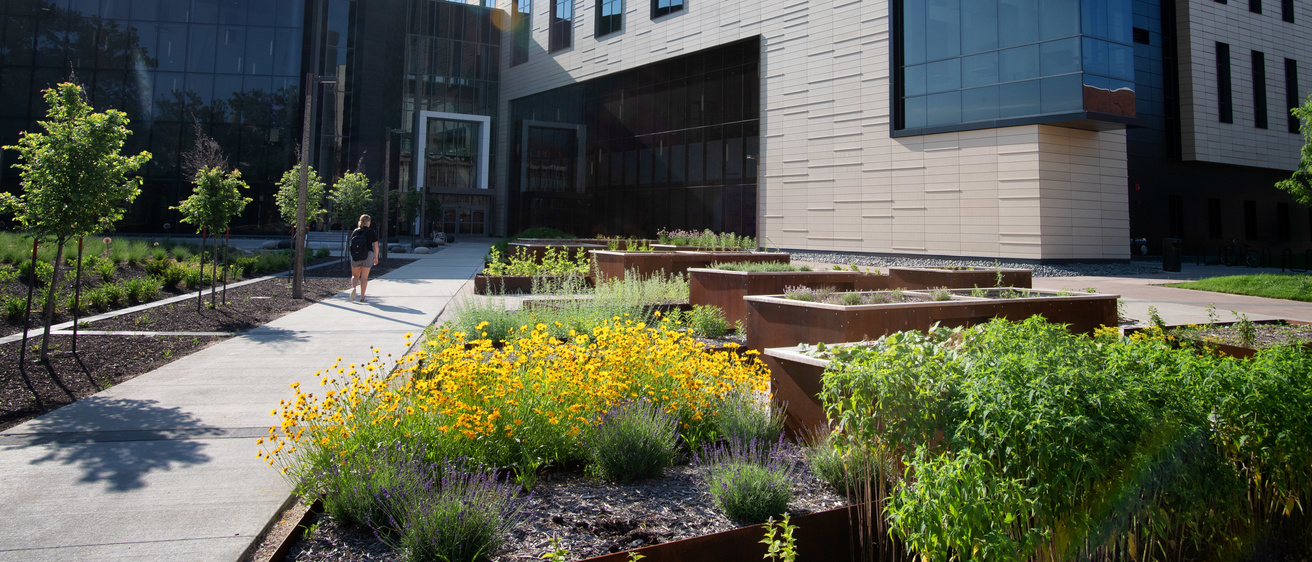Humans have always sought healing from plant life, and this exploration is how the pharmacy profession developed. Scientists still look to the environment for treatments and cures. Accordingly, plants with medicinal properties are a main highlight of the vast front grounds of the new UI College of Pharmacy building.

When approaching the building, or looking out its many windows, you will see a well-groomed, colorful array of medicinal plants in full bloom in raised, angular planter boxes along concrete paths. Each plant has a sign next to it with its common and scientific name, and a barcode. Snap a picture of the code—a QR Code—with a cell phone, and it will open a web browser with more information about the plant's past, present, and future.
A stroll through the garden has never been so informative.
Here’s one example: if you take a photo of the Tiger Lily sign with a mobile device, a webpage will appear with a stylized photo of the plant from a 1626 book, and a link to the library on campus where you can find it. Scrolling down, you will see that it was “historically prized in the east for its edible bulbs”, and is “being investigated for cancer cell suppression” and other uses. Each plant’s entry also links to its latest PubMed research.
The project—called the Roots of Medicine—comes from three main sources:
- Images and information from rare books in the John Martin Rare Book Room of the Hardin Library for the Health Sciences (HLHS), as well as the National Institutes of Health (NIH) National Center for Complementary and Integrative Health,
- Modern, cutting-edge medical research, and
- Digital technology.
The project was the brainchild of Elizabeth Kiscaden, formerly of Hardin. Its collaborators are Hardin and its rare book room; the college; a local gardening group; and Mark Widrlechner, a horticulture expert from Iowa State University.
“The earliest drugs came from plants, bark, roots, and shrubs,” noted UI Pharmacy Dean Donald Letendre. “Having a path surrounded by pharmacologically active plant life is a tangible reminder that where people and plants come together, medicine results.”
The earliest historical books that are linked to should be taken with a grain of salt, according to Damien Ihrig, curator for the John Martin Rare Book Room. Ihrig spoke about the history of plants in medicine in a video created by the Iowa Bibliophiles, part of Special Collections & Archives at the University of Iowa Libraries.

The other highlight of the pharmacy lawn is a large-scale sculpture called Synthesis, built by Gail Simpson and Aristotle Georgiades of Actual Size Artworks. The sculpture is a giant abstract metal mortar and pestle that appears to be exploding. Its name comes from its mission: To unite and highlight the connections between three nearby elements—the new building, its medicinal gardens, and the nearby wooded ravine.
“The juxtaposition of the ravine, and pharmacologically-active plant life in the medicinal gardens; and the cutting-edge science and discovery that we have in our brand-new facility is brought together in the exploding mortar and pestle. The sculpture provides a symbolic gateway from past to present,” Letendre said.
Fittingly, United States Pharmacopeia has chosen this location to recognize individuals with ties to Iowa Pharmacy for their many contributions to the quality of modern medicines. The contemplative nature of the location has also become a popular spot to memorialize former pharmacy alumni, forever linking their past to present-day Iowa Pharmacy.
“That mortar and pestle explodes to the new facility, recognizing the contributions of those who have come before, and positioning us so well in our continuing efforts to manipulate molecules and create new drug entities.”
Excerpts from the poem “Remember” by Joy Harjo—U.S. Poet Laureate and Iowa Writers’ Workshop alumna—are etched into the pathways near the sculpture to express a strong connection to nature.
|
University of Iowa Gardeners plan to maintain the gardens. The UI Libraries Digital Scholarship & Publishing Studio created the Roots of Medicine website and logo.
|
The new College of Pharmacy Building (CPB) opened in January 2020. The long-awaited in-person Building Dedication ceremony will take place on October 15, 2021.
